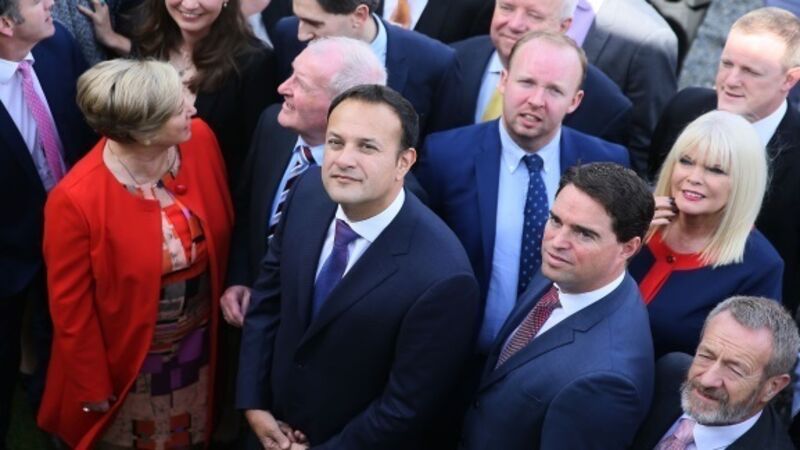Special Report: Futuristic €115bn National Framework Plan aims to modernise the country

It is the 25-year plan that will see billions of euro pumped into transport, jobs, education, health, roads, railways and airports.
Tomorrow the Government, through its Ireland 2040 initiative will outline how it wants the country to look in the decades ahead when the population is expected to have grown by one million people.
In that time an extra 550,000 homes will be required, while there will be a need to create an additional 660,000 jobs.
And so the Government, in a bid to answer where we will live, how we will travel, where we will be taught, and what services will be available for the sick and elderly, has come up with a national planning framework dubbed ‘Ireland 2040 — Our Plan’.
In the first 10 years of this forward-thinking plan, €115bn will be invested in infrastructure, including a new national children’s hospital, an expansion of the Dart as well as the building of schools, social housing and Garda stations.
And what for rural Ireland? Country dwellers have already seen the boarding up of post offices, Garda stations and smaller bank branches.
They have been stymied by a lack of connectivity and the reneging on the introduction of broadband. They have seen farmers seek part-time work elsewhere out of necessity and the young generation move away to third-level education never to return.
It is unsurprising that this exasperated group is not holding out much hope for what could simply become an updated version of many failed strategic plans of past governments.
However, rural Ireland is also a vibrant place to live, full of people who have a deep attachment to the land, the soil, the village, the town where in many cases generations of their family have eked out a living.
All they ask for is a little support to allow them access education, healthcare and jobs.
Under-investment, many warn, will simply lead to a vicious circle which encourages abandonment of areas and in turn leads to further reductions in funding.
Some of the details of the Government’s long-term initiative have been well flagged ahead of tomorrow’s grand unveiling. The plan can be divided into two parts, the 10-year development plan and the longer-term national framework which will extend out to 2040.
Cork, for example will get a new acute hospital and there will be three elective-only facilities created — one in Dublin, one in the west and one in the south. The national children’s hospital and the national maternity hospital have also been brought into the package.
The much-anticipated €850m motorway linking Cork with Limerick is expected to get the green light under the 10-year plan.
Other proposals expected to be in the plan are an extension of Dart services to Drogheda and Dublin Airport will be given a second runway.
However, many TDs, including some rural Fine Gael backbenchers, after getting sight of the Government’s draft version of the National Planning Framework when it was published in the autumn, expressed shock that an imaginary line had been drawn from Dublin to Galway and everything above that line had been ignored.
Those under the line and living in rural areas also claimed that they had been forgotten about with a focus on larger regional centres and the main cities.
Indeed, in recent months it has been acknowledged that Finance Minister Paschal Donohoe and Housing Minister Eoghan Murphy have significantly tinkered with the plan to give it more of a regional edge.
Such was the furious response to the draft plan, that Independent TDs and members of several political parties set up the National Planning Framework Coalition led by Alan Kelly, Éamon Ó Cuív, Michael Fitzmaurice and Eoin Ó Broin.
Mr Kelly said: “This plan has taken three years to write, it has had much consultations, views etc and we believe that is all a very important process.
“How can in the space of three to four weeks the whole plan be, to quote the Taoiseach, ‘substantially changed’, how can all the components, all the research all the population analysis, all have changed so quickly in the space of a couple of weeks?”
Mr Ó Cuív called for the establishment of a cross-party committee similar to the one which examined the future of the healthcare service through the Sláintecare report.
“We have to remember that we are talking about a 23-year plan and whatever happens in that period there is one thing certain — there will be changes of government, there will be changes here in Leinster House and what we need to do is get the biggest consensus we can and to ensure that all of the largest parties and others are bought into the plan,” said Mr Ó Cuív.
Whether enough has been done to dispel the notion that the Cabinet — led by two Dublin ministers — has taken the usual Dublin-centric view of the country when devising the plan remains to be seen.
The decision to bring the Cabinet on a jaunt to Sligo tomorrow to announce the plan signals that the northwest has been drafted back into the framework.
However, speaking in Dublin last week, Taoiseach Leo Varadkar warned that the plan must be realistic.
“When I hear people talking about turning every town into a city and every village into a town, and railways to everywhere, that would not be viable and would require massive subvention at the expense of our health budget and our education budget,” said Mr Varadkar.
However, Seamus Boland CEO of Irish Rural Link says those living outside major cities and towns simply want balanced regional development and believes rural dwellers are realistic about what can be delivered.
“We don’t need a hospital in every town and village, for example. In fact what we need is a comprehensive hospital system linked to the best hospitals in the world,” he said.
Mr Boland says population hubs of 30,000 to 40,000 must be created which would allow for the creation of centres of employment for those living in rural areas, but this would also require a significant investment in rural transport links.
Any plan cannot be orientated towards the bottom line as people living in rural Ireland are tired of hearing the crudest cost/ benefit arguments employed against investing in rural infrastructure and access.
This is the view of Irish Creamery Milk Suppliers Association president Pat McCormack who says that a strategy of underinvestment can become a self- fulfilling argument for further under-investment.
“It’s nonsensical to hear someone say that it doesn’t make sense to invest in a rural area because the population base there doesn’t justify that. That non-investment then leads to more people deciding not to live in the rural area and to live in the urban or suburban environment instead.
“That leads to another fall in the rural population and so the next time we come to decisions or a review about a capital spending plan the same economist says ‘But the population in County X has fallen again so we’re throwing good money after bad – let’s build another multi-billion Luas line in Dublin’,” said Mr McCormack.
‘Rural Ireland is dead and gone, it’s with O’Leary in the grave’ cannot become the lament of those living outside urban areas.
A small bit of imaginative thinking, targeted supports and a realisation that rural Ireland is a vital part of the fabric of this country would easily prevent an updating of the famous line penned by a Sligo poet more than 100 years ago.
Transport: Infrastructure outside capital not up to scratch
All roads, as Taoiseach Leo Varadkar said at the weekend, will no longer lead to Dublin if and when the national framework plan promises are introduced.
However, that doesn’t mean the country’s transport infrastructure outside the capital is anywhere near up to scratch right now.

And far from being a minor inconvenience for rural communities, the issue is posing real difficulties for the country as a whole, curtailing future economic growth and was squarely blamed for Ireland losing out on the right to host the 2023 Rugby World Cup.
While diverse, the rural transport problems ultimately amount to three issues — lack of investment, lack of a large enough base of users to justify funding injections, and as a result a lack of opportunities to encourage job and community growth in areas badly hit by the recession.
Whether it is on the roads or along the railways, the problem remains the same, and is something the Government must ensure is properly tackled in the framework plan when it is published in Sligo on Friday.
The roads difficulties will be nothing new for anyone who has travelled by car throughout Ireland since the Celtic Tiger came to a shuddering halt a decade ago.
Outside of Dublin, the network of regional and local roads spans almost 91,000km, accounting for 94% of the national network and taking in more than half of all road users.
However, according to the latest National Oversight and Audit Commission report, almost three in every four of these roads have serious structural or surface defects, an issue acknowledged by Department of Transport officials at a Dáil public accounts committee meeting late last year.
Separately, the long-term problem of linking cities outside of Dublin to each other is also affected by the existing road system, hampering hopes of spreading economic growth to all regions and satellite towns and communities near cities outside the capital — an issue that is vital to ensuring long-lasting job prospects for all parts of Ireland and, as the failed 2023 Rugby World Cup bid showed, encouraging high-profile investment opportunities for this country.
While the Government has made it clear it intends to address this issue in the framework plan by committing to building the €850m Cork to Limerick motorway, the fact that this project has been criticised by a key research from the framework plan is unlikely to instil confidence in rural Ireland that there is as much commitment to addressing its transport problems as is officially claimed.
The situation for the railway network outside of Ireland’s urban centres is not much better, with repeated friction between communities which insist investment is needed and equally legitimate concerns from Iarnród Éireann bosses that such investment cannot be justified due to the small number of people using certain services.
Of particular concern is the lack of a joined up rail network in the western corridor, with commuters unable to travel direct between Cork and Galway — and further north — severely curtail opportunities for investment in Ireland’s second and third largest cities.
In addition, a lack of footfall on some rail lines such as the Limerick to Ballybrophy line has led to repeated claims Iarnrod Éireann may need to cut some tracks in order to resolve an expected €103m company shortfall in the next five years — an issue that has led to significant concern parts of rural Ireland are being left behind instead of having their public service needs catered for.
In the Dáil this week, with one cynical eye firmly on the framework plan’s publication tomorrow and the need to highlight the existing rural transport problems to counteract the Government’s PR-garnished solutions, Fianna Fáil transport spokesperson Robert Troy insisted action is needed now on addressing the glaring gaps in rural Ireland’s transport system.
While the opposition party’s claims need to be seen in the frame of political jousting, to ignore them completely would be a mistake.
Whether all roads lead to Dublin or not, it is an issue the Government will be acutely aware of when it launches its national framework plan on Friday — and, crucially, as it looks ahead to the next general election hurtling towards them along their transport promises.
Rural Affairs: Brief is still toothless and badly financed
“How goes the new department?” Rural Affairs Minister Michael Ring was asked a few weeks before the budget.
“Don’t mention the war,” he said, with a stressed look on his face, as he continued past me on the long, narrow corridor of Leinster House.
On his elevation to Taoiseach, last summer, Leo Varadkar decided to promote Ring to Cabinet and to establish a new department of rural affairs.
Flagged as a sign that the Government was taking rural Ireland seriously, in truth it was a political sop to the West, on Enda Kenny’s exit from the Cabinet.

For all of the positive talk and potential success of the new, embryonic department, its first seven or so months have been less than stellar.
With little or no devolved functions, a minuscule budget, and no permanent home (it has moved from Kildare Street to Clare Street and will finally end up on Nassau Street), it has been dismissed as a “token” by Mr Ring’s opposition counterparts.
“Staffing has been a real issue and, like any new department, there is a real sense of people not knowing what it is really about and for,” one senior official told me.
It was only last month, when he took his first question time as Minister for Rural and Community Development, in the Dáil, seven months after he was appointed to the role, that Mr Ring finally got to answer questions on his portfolio.
It followed the lengthy resolution of legal and administrative changes required in untangling his remit from the old Department of Arts, Heritage, Regional, Rural and Gaeltacht Affairs to create the first dedicated Department of Rural and Community Development.
Mr Ring, who is as canny a political operative as they come, has been sensitive to those criticisms. He was said to have “let fly” at Mr Varadkar and Finance Minister, Paschal Donohoe, at Cabinet, on the morning of the budget.
He was displeased at the lack of progress in the formal establishment of his newly created department, and was a lone dissenting voice at Cabinet on the morning of the budget.
While most ministers offered comments in support of the €1.2bn budget package, Mr Ring broke ranks and “let fly” and made known his displeasure at the lack of meaningful financing for his department. It got €19m, or 12% of an increase.
“When Leo went around the table to ask for views on the budget, everyone said ‘happy, happy’ and then it came to Ringer, who let fly. He was very angry,” said one minister.
“It is not that rural Ireland is not a priority, but when you are putting out fires in other areas, they have to be the priority. They are health and housing.”
He made the point that if he is not being looked after, he is being “thrown to the wolves” of the opposition, such as Fianna Fáil’s Éamon Ó Cuív and Roscommon Independent, Michael Fitzmaurice.
Fitzmaurice told the Irish Examiner: “Michael Ring was right to give out. He has the smallest budget for a department that covers most of the country. It is a token gesture to rural Ireland, with the budget he has. Nothing else.”
Ó Cuív said Mr Ring’s department is a “Cinderella” department, because of the tiny budget it has and very limited functions.
“What can he do for rural Ireland, with a tiny budget and little or no delegated functions?” he said.
More recently, Mr Ring made his unhappiness known over the original “final draft” of the National Planning Framework, which is to be launched this Friday in all its glory.
Deeply unhappy with its Dublin bias, Mr Ring sought for a much more equitable split in the €115bn spend over the next decade.
Housing Minister, Eoghan Murphy, had to politically proof the budget by running it past Ring for his approval.
Now, he is said to be fully on board and satisfied, with the North West, including Mayo, likely to do quite well out of the large capital spend.
His handlers, too, will point to the success of local rejuvination schemes, like money for greenways and village renewal projects, but all of that, in truth, is tinkering around the edges of a far greater problem.
Ultimately, if the department is to be taken seriously, it will need more than a passionate minister. It needs proper staffing, a proper budget, and proper powers.
Until that occurs, the accusations stand of the department being a mere sop or token to rural Ireland.
Post offices: Time to stamp action on future of network
Speaking in the Seanad recently, Taoiseach Leo Varadkar blamed the online world we now live in for the demise of post offices.
“If we are to judge the success or failure of rural Ireland, we should not base our view on the number of post offices and Garda stations,” said Mr Varadkar.
“The number of post offices is going down everywhere, including in the cities, because people now have bank cards and use the internet.” There is no future in selling stamps — postmasters have long accepted this.

What those serving communities up and down the country cannot accept is a lack of support for the many diversification options put forward by postmasters themselves and the mothballing of numerous reports drawn up with recommendations to forge a future for the network.
Postmasters, many of whom supplement their income with secondary businesses and see the social and community element of their position as just as important as the official postal service they provide, are willing to get on board with online business and want to extend the services they provide.
The country’s post offices want to be given the chance to deliver remote health checks with hospital and GP link-up via technology; become a drop-off point for prescriptions; a local transport service hub; and tourist information point.
They also want clarity around the number of post offices that will be in operation in the coming years. They accept that the number will dwindle further but are demanding more certainly around this so they can plan for the future and ensure isolated and rural communities are catered for.
In the past 25 years the number of post offices has steadily dwindled from 1,907 in 1992 to around 1,130 now — between 2007 and 2010 alone there were 198 post office closures.
Far from allowing the slow death of the rural post office to continue, Irish Postmasters’ Union general secretary Ned O’Hara said the network can provide a major opportunity for the Government to transform citizens’ access to services and become a “social hub” in the community.
For instance, in Ballymore Eustace, Co Kildare, VideoDoc, the first ever online GP postmaster service, now provides locals with a virtual medical consultation.
From a private booth in the post office, a doctor is able to triage, treat, diagnose, prescribe, and follow up with patients via video link.
“There isn’t a one-size-fits-all answer to this. Some areas might benefit from a tourist information service, others might use the VideoDoc, others could take on banking,” said Mr O’Hara, adding that the important thing is that post offices are given the scope to change.
What is most needed to protect rural post offices, which in many cases act as the only social outlet elderly and isolated people have, is action.
It is now more than two years since businessman Bobby Kerr published his report recommending immediate action to tackle serious challenges facing the network.
The report found many rural and isolated post offices are not viable and must adapt to remain open in the coming years, but little in the way of new services has been rolled-out.
Last year, the Public Banking Forum of Ireland suggested post offices should become the primary mortgage providers for first-time buyers — again there has been little movement on this.
Before Christmas, the Government announced a €30m investment plan in the post office network to support the continuation of a five-day week postal service and allow for an expansion of its parcel delivery service. However, there are still question marks over what amount, if any, will go towards other network-saving measures.
There is no doubt that post offices are no longer about the sale of stamps, postmasters are enthusiastic about their future, but they must get the backing to continue on the vital role they play in communities.
Crime and policing: Communities ‘crying out’ for Garda stations
Recent political debate and charges of cronyism over the reopening of Stepaside Garda station in south Dublin have focused minds on the level of cutbacks in policing.
Rural communities felt the blunt of reduction in garda numbers, specifically when the last Fine Gael government closed 113 stations.
Taoiseach Leo Varadkar, echoing comments by ex-Justice Minister Alan Shatter who made the cuts, said stations closed as they were built before there was a fleet of Garda cars.

However, what comfort is that for isolated families or elderly residents who come face to face with a robber?
Rural crime and Garda station closures have haunted this and the last Fine Gael government. Gangs are increasingly mobile.
Thieves come off major routes, rob homes and then drive away. And rural communities affected by the closure of Garda stations in towns and villages are feeling vulnerable.
Last year was dominated by a number of high-profile rural crimes and aggravated burglaries, with some particularly disturbing cases.
In February, Paddy Lyons, 90, suffered a violent death at his rural home in Ballysaggart, Lismore, Co Waterford.
The reality of rural crime was also brought into focus in May when 94-year-old Jimmy Campion was beaten around the head by burglars in front of his 87-year-old wife Maura. The attack happened late on a Sunday night at their cottage on Old Dublin Road, Roscrea, Co Tipperary.
Both of these horrific attacks are a reminder of the problem of rural crime.
There have been calls for the reopening of Garda stations in rural areas that are vulnerable to criminal activity and without a nearby 24-hour Garda presence; for increases in funding and support for Garda-controlled CCTV and the promotion of GPS tracking devices to help protect against the robbery of farming machinery.
So what is the Government and gardaí doing to tackle the incidents and vulnerabilities?
Statistics released last month by the Garda press office show an increase in burglaries last year was reversed by the year’s end, where nationally rates fell by 23% in November and December under the Winter Phase of Operation Thor, which targets burglary gangs.
Under new legislation, repeat offenders or prolific burglars will also be targeted in the courts. Bail can be refused while electronic monitoring may be imposed under bail conditions.
The implementation of these measures is under way. Furthermore, the Government wants to increase the force to 21,000 by 2021.
Also, six Garda stations, including Stepaside, will be reopened after Garda recommendations. These also include stations in Rush, Co Dublin, Leighlinbridge in Co Carlow, Donard in Co Wicklow, Bawnboy in Co Cavan and Ballinspittle in Co Cork.
Addressing the Seanad recently, Taoiseach Leo Varadkar responded to concern about the closure of post offices and Garda stations. He told the upper house that post offices are closing because people have bank cards and internet, while Garda stations are closing because they were built before there was a fleet of Garda cars. The remarks triggered criticism.
One problem in addressing these issues is verifying what level of rural crime actually exists.
Unfortunately, the Central Statistics Office has stopped publishing crime data since the last quarter of 2016 because of differences with gardaí over the compilation of the data.
However you look at it, rural Ireland feels under attack, robbed of its security and in fear of its future.
Even the issue of rural crime is being considered by the Commission on the Future of Policing in Ireland. At public meetings, commission members say common themes being raised include rural crime, with rural joint-policing committees reporting increasing rates of burglaries among incidents.
Expect this issue to be a big debating point in any general election.
Health and education: Fears over downgrading of rural services
Among doctors with a flair for a phrase, it is called the medical apartheid of Ireland.
And while the claim does not always ring true, fears over the downgrading of rural health services and the lack of supports compared to major urban areas is a constant bone of contention — something any politician will know all too well after any constituency canvass.
Due in part to the 2002 Hanly report plans to downgrade services in rural hospitals, a similar attempt by PDs TD and former health minister Mary Harney in 2007, and the deep cuts imposed on public services during the economic crash, there is a legitimate belief in rural Ireland that its medical needs come second to those of large areas.

This is where the medical apartheid claim comes into play, with the allegation repeatedly made that if someone was to draw a line from Dublin across the country, they would see a severe shortage of trauma services above the line, with a similar lack of substantial supports apparent outside of Dublin, Cork, Limerick, and Galway.
The Department of Health has been at pains to counter the claim in recent years, creating centres of excellence for various conditions in hospitals nationwide and reforming hospital structures to create hospital groups that link facilities with each other to speed up access to care.
Such moves — alongside last week’s trauma services announcements and plans to build a new acute hospital in Cork in addition to elective-only hospitals in Dublin, Cork, and Galway — are to be welcomed.
However, the concerns are added to by further health problems in rural areas, in particular an ageing population, a dearth of new GPs to replace those retiring and leaving villages and towns without any general practice cover, and ongoing concerns over serious gaps in ambulance care for isolated parts of the country.
A similar difficulty is apparent when it comes to schools in rural areas, with dozens being shut or effectively shut through mergers due to their size in recent years.
As with almost all rural issues, the Government claims its national framework plan will promise to address it when it is revealed in Sligo tomorrow, the rural schools issue has its roots in the darkest years of the economic crash.
In 2011, then Labour TD and education minister Rúairí Quinn controversially sought to reform the small schools system by changing the threshold for small rural schools to be given an extra teacher based on their pupil ratios.
The situation led to a large number of small school closures in the subsequent years and, while the threshold has now been reversed, there remains an ongoing suspicion in rural communities that their schools are being encouraged to merge — effectively seeing one or more close — in order to save costs and better accommodate dwindling local population numbers.
The Irish National Teachers’ Organisation has recently warned it is “unfair and short-sighted” to “push” small schools to amalgamate with each other, openly questioning the Government’s approach to the issue.
In a statement after its latest annual congress in Belfast last year, the cross-border union said that there are currently 588 schools with less than 50 pupils in Ireland, and that small schools need to be “valued” — both for the education system and the impact a school closure can have on a rural community itself.
While noting the “political taboo” phrase ‘school closures’ is rarely used by Government representatives, the INTO congress said this is the reality of what is happening, adding rural areas are being unfairly affected by the issue.
With such legitimate health and education concerns affecting all households in rural Ireland, the Cabinet will do well to address the fears — whether legitimate or not — in tomorrow’s high-profile national framework plan announcements.
Broadband: Talks rumble on in search of connections
Up and down the country, internet blackspots disrupt daily life: Families cannot bank online, students can’t file assignments; farmers can’t access grants, and shops cannot trade.
It is an indictment of a modern country, where high-speed broadband access is now being equated to the electrification of homes in the 1950s.
The shock withdrawal of Eir from tendering for the national broadband plan has raised fresh concerns about proposals to connect 540,000 mainly rural homes.
Just one provider, Enet, remains in play. Amid clamour for a review, the Government insists the plan is on track for full rollout by 2023 and that a contract will be signed by September.
How does Enet’s bid stand-up, particularly now Eir and Siro (the latter a Vodafone/ESB venture) have jumped ship? And what does this mean for the national broadband plan and taxpayers?

Enet is a consortium, made up of SSE — owner of Airtricity — Granahan McCourt, and the John Laing Group.
SSE and Granahan McCourt last year unveiled plans to bring fibre broadband to 115,000 homes and businesses not covered by the national broadband plan. In other words, it already has involvement in the sector.
It is also worth considering the market spread of and funding for Enet.
Of the original three bidders, Enet is the only wholesale operator. A state-backed fund also bought two thirds of Enet. The two issues strengthen Enet’s position.
Existing questions linger about Enet’s ability to do the job, especially given that ESB and Eir both have existing connections into homes nationwide.
Essentially, Enet, if it is the winning bid, will have to negotiate access to Eir’s polls and ducts, to hook up the high-speed broadband.
Eir could insist on a price of up to €20 a pole annually. That is a huge cost with 1.3m poles under the national broadband plan. But can the Government legislate to cap these costs? The crunch issue could end up in court.
The success of Enet’s national broadband plan venture may come down to how it cuts a deal for rural infrastructure already owned by Eir, formerly Eircom.
So all of this is in part a gamble, a jump into the unknown.
Communications Minister Denis Naughten says any delays have not been under his watch. The national broadband plan was promised back as far as 2012. Furthermore, there is strict overview of this plan, insists Mr Naughten.
Enet might be the sole bidder, but its bid will go through several tests.
The national broadband plan is subject to a steering group and procurement board, including national and international experts. The final subsidy for the winning tender will be go through a value-for-money assessment by the National Development Finance Agency. National broadband plan spending is also subject to an audit by the Comptroller and Auditor General.
Mr Naughten maintains that the Enet-led consortium has vast international experience across telecoms, engineering, and infrastructure sectors. Nonetheless, a fear among opposition benches is that Siro and Eir backed out of the bid because of onerous bidding terms dictated by Mr Naughten’s department.
Questions raised include why Eir was allowed ‘cherry-pick’ 300,000 homes out of the 850,000 intervention target, leaving the more isolated premises in the national broadband plan. This made the project less attractive for bidders, it is claimed, and now just one consortium is left in control — Enet.
Nonetheless, Enet has rejected accusations that it is not big enough or equipped to do the job. It says that in the US it has spent $100m a month on projects.
Furthermore, Enet’s partner for the national broadband plan is SSE, which has injected €2bn since 2008 in energy projects in Ireland.
Overall, the reality is there just isn’t a plan B, at least not one to release publicly.
This could be the best deal to give rural homes the same type of connection speeds around the country that match those in any big city.
Furthermore, a strict vetting process is there to protect the State’s interest.
It is now down up to Mr Naughten to ensure there is no slippage on the timeline, loose ends in the terms for Enet, and, most importantly, the needs of 540,000 homes who need this remain at the top of the plan.











